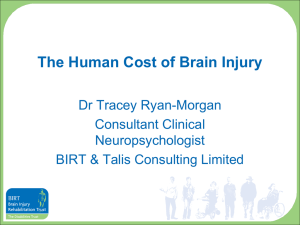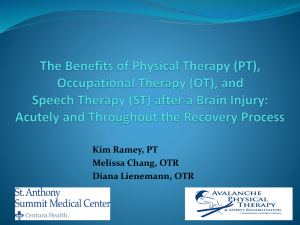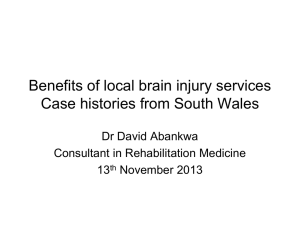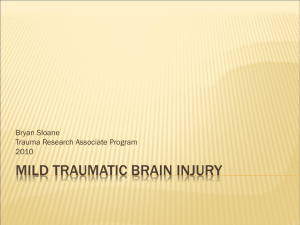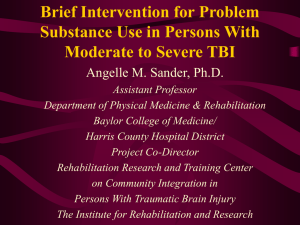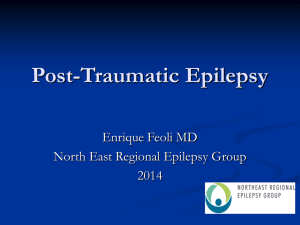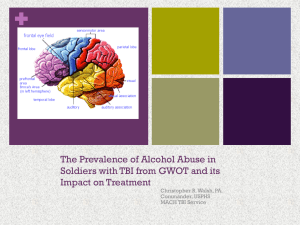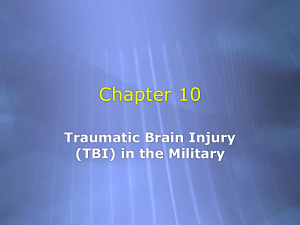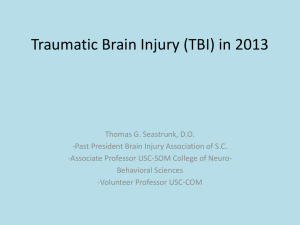TBI Traumatic Brain Injury - Purdue University Calumet
advertisement
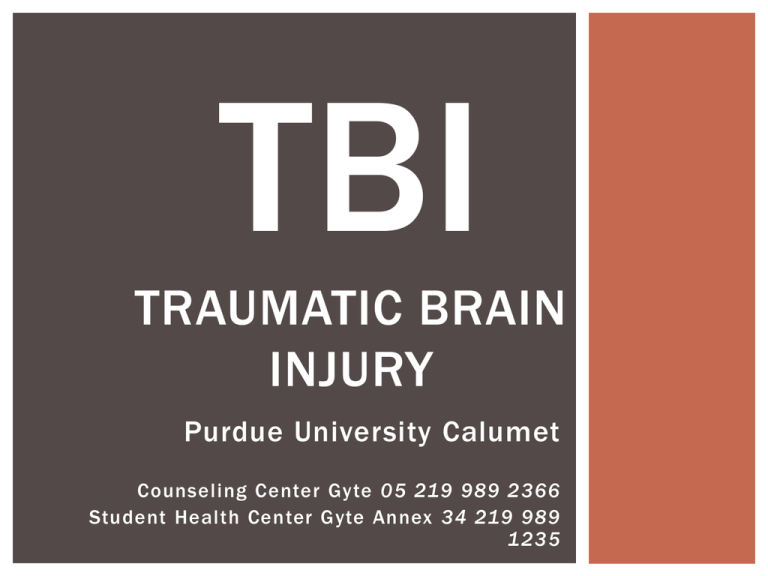
TBI TRAUMATIC BRAIN INJURY Purdue University Calumet Counseling Center Gyte 05 219 989 2366 Student Health Center Gyte Annex 34 219 989 1235 WHO IS AFFECTED BY TRAUMATIC BRAIN INJURY TBI ? 1 .5-2 million adults and children suf fer TBI annually Approximately 1 .1 . million have mild injuries and do not require hospitalization 250,000 will be hospitalized with moderate to severe head injuries 50,000 die from their injuries -Figure 1. Diffuse Injuries. Mayfield Clnic, 2014. Retrieved from http://www.mayfieldclinic.com/PE-TBI.htm Figure 2 . Traumatic Brain Injury. Mayfield Clinic, 2014. Retrieved from http://www.mayfieldclinic.com/PE-TBI.htm WHAT IS TBI? Traumatic brain injury (TBI) can occur when something outside the body hits the head with significant force. Whether it is a head hitting the windshield during a car accident, an impact from a fall, head injuries received during sports or other recreational activities , or trauma from a nearby blast or explosion, TBI can cause changes in a person’s ability to think, control emotions, walk, or speak, and can also af fect sense of sight or hearing. WHAT ARE THE CAUSES OF TBI a head hitting the windshield during a car accident an impact from a fall head injuries received during sports or other recreational activities trauma from a nearby blast or explosion or assault with or without weapons LEADING CAUSES OF TBI The leading causes of TBI: -Falls (40.5%): -Motor vehicle – traffic (14.3%); -Struck by/against events (15.5%); -Assaults (10.7%).1 Figure 3 . Leadings causes of TBI. Center for Disease Control. Retrieved from http://www.cdc.gov/traumaticbraininjury/get_the_facts.html#causes LEADING CAUSES OF TBI Falls -Falls continued to be the leading cause of TBI (35.2%) in the United States. -Falls cause half (50%) of the TBIs among children aged 0 to 14 years and 61% of all TBIs among adults aged 65 years and older. Motor Vehicle-Traf fic Crashes -Motor Vehicle Accidents MVA is the leading cause of TBIrelated Death (CDC, 2014) -Rates of death from TBI from MVA are highest for adults aged 20 to 24 years (CDC, 2014) LEADING CAUSES OF TBI CONT. Struck By/Against Events -Struck by/against events, which include colliding with a moving or stationary object, were the second leading cause of TBI among children aged 0 to 14 years, with 25%. Assault - Assaults produced 10% of TBIs in the general population; they accounted for only 2.9% in children aged 0 to 14 years and 1% in adults aged 65 years old and older. HOW IS TBI CLASSIFIED ? TBI can be further classified according to findings from various imaging tests (CT scan MRI and PET scans) Both individual findings from such tests as well the collective results influence both Prognosis and Treatment for victims of TBI See Primary and Secondary Injury PRIMARY INJURY IN TBI Occurs at the time of the injury Relates to the “mechanism of injury” and includes Direct impact Rapid acceleration and deceleration (see next slide Coup countercoup) Penetrating injury Blast waves All these mechanisms result in trauma to the brain from mechanical forces including: Bruising swelling Bleeding Actual shearing of the white matter of the brain (predicts poor outcome) Figure 4 . Coup Contrecoup Injury. Wikipedia, 2014. http://en.wikipedia.org/wiki/Coup_contrecoup_injury SECONDARY BRAIN INJURY IN TBI Includes damage that occurs over hours to days and occurs at the cellular level in the brain such as: Free radical injury to cell membranes Electrolyte imbalances Inflammatory responses Cellular death Ischemia from vascular injury It is these secondary injuries that current medical research is attempting to limit or prevent. No current treatments have demonstrated clear benefit DID YOU KNOW? TBI FACTS: TBIs can occur on the battlefield, on the football field, on the playground, in a car accident, and even at home. There are four categories of TBI including mild, moderate, severe and penetrating. A mild TBI (mTBI), which is also known as a concussion, is the most common form of TBI (see Next Slide). Figure 5. Concussions and Mild TBI. Center for Disease Control, 2007. TBI SYMPTOMS Injuries can range from mild concussions to severe permanent brain damage. The consequences of a brain injury can af fect all aspects of a person’s life, including physical and mental abilities as well as emotions and personality. TBI can result in changes in a person’s physical functioning, thinking abilities or cognitive function, and behavioral ef fects and they are often interrelated. These ef fects sometimes cause other dif ficulties such as sleeping problems, depression, and anxiety. TBI SYMPTOMS CONTINUED Depending on the type and location of the injury, a person’s immediate symptoms may include: Loss of consciousness Confusion and disorientation Memory loss / amnesia Headaches Visual problems Poor attention / concentration Sleep disturbances Dizziness / loss of balance Irritability / emotional disturbances Feelings of depression Seizures Vomiting SYMPTOMS: General Difficulty speaking Blurry eyesight Trouble hearing Loss of energy Change in sense of taste or smell Dizziness or trouble with balance Behavioral effects may include: Becoming angry easily Getting frustrated easily Acting without thinking Cognitive effects may include: Difficulty concentrating Trouble with attention Forgetfulness Difficulty making decisions Repeating things Behavioral effects may include: Becoming angry easily Getting frustrated easily Acting without thinking SYMPTOMS Thinking/Rememberi ng Difficulty thinking clearly Feeling slowed down Difficulty concentrating Sensitivity to noise or light Balance problems Physical Headache Fuzzy or blurry vision Nausea or vomiting (early on) Dizziness Emotional/Mood Irritability Sadness More emotional Sleep Sleeping more than usual Sleep less than usual Trouble falling asleep Figure 6. Symptoms of brain injury. Center for Disease Control, 2014. Retrieved from http://www.cdc.gov/concussion/signs_symptoms.html Difficulty remembering new information Feeling tired, having no energy Nervousness or anxiety HOW IS A DIAGNOSIS MADE? When a person is brought to the emergency room with a head injury, doctors will learn as much as possible about his or her symptoms and how the injury occurred. The person’s condition is assessed quickly to determine the extent of injury. Diagnostic Imaging Tests: -Magnetic Resonance Imaging (MRI) -Magnetic Resonance Spectroscopy (MRS) -Computed Tomography (CT) -PET scans DIAGNOSIS TEAM A professional may work with his or her family/caregivers as part of a team that may also include: doctors nurses Neuropsychologists and clinical psychologists occupational therapists physical therapists social workers employers teachers TREATMENT FOR CHRONIC TBI Disabilities from TBI may last a lifetime, and dif ferent interventions may be appropriate even many years later. This is particularly true for survivors of moderate to severe TBI. It is essential for survivors, their families, and caregivers to be involved in designing and implementing the rehabilitation plan. Patients may have residual symptoms that require skilled management by qualified neurologists, physiatrists, and neuropsychologists There are two categories of chronic treatment: Community -based rehabilitation and return to work or school, and Treatment of long-term consequences of the injury. MENTAL HEALTH RELATED EFFECTS OF TBI TBI symptoms can af fect people in dif ferent ways and sometimes symptoms change as people recover. Some people may recognize TBI symptoms immediately, and others may write them of f or minimize what they’re experiencing. The ef fects of mild TBI usually get better on their own and may be unnoticeable within three months. Some moderate to severe TBI symptoms last for a longer period of time or may be permanent. However, there are ef fective treatments and support for helping Veterans manage their symptoms and find a path to recovery. MENTAL HEALTH RELATED EFFECTS OF TBI Feeling tired all the time Feeling sad and anxious Getting frustrated or overwhelmed easily Sleeping much more or less than usual Feeling irritated or angered all the time Doing things without stopping to think Having trouble concentrating, remembering, or focusing on tasks Drinking more alcohol Taking more of a prescription or over -the-counter medication than as directed Using illegal drugs Smoking or using tobacco more often Not feeling like yourself PHYSICAL PROBLEMS FROM TBI Decreased strength and coordination in the body, arms, and legs Hearing loss Tinnitus (ringing or buzzing in the ears) Headaches Seizures Dizziness Nausea Vomiting Blurred Vision Decreased smell or taste COMMUNICATION PROBLEMS FROM TBI People with a brain injury often have cognitive (thinking) and communication problems that significantly impair their ability to live independently. These problems vary depending on how widespread brain damage is and the location of the injury . The person may have trouble with social communication, including: taking turns in conversation maintaining a topic of conversation using an appropriate tone of voice interpreting the subtleties of conversation (e.g., the difference between sarcasm and a serious statement) responding to facial expressions and body language keeping up with others in a fast -paced conversation COGNITIVE PROBLEMS FROM TBI Trouble concentrating when there are distractions (e.g., carrying on a conversation in a noisy restaurant or working on a few tasks at once). Slower processing or "taking in" of new information . - Longer messages may have to be "chunked," or broken down into smaller pieces. - The person may have to repeat/rehearse messages to make sure he or she has processed the crucial information. - Communication partners may have to slow down their rate of speech. COGNITIVE PROBLEMS CONT. Problems with recent memory. - New learning can be dif ficult . - Long-term memory for events and things that occurred before the injury, however, is generally unaf fected (e.g., the person will remember names of friends and family). Executive functioning problems. - The person may have trouble starting tasks and setting goals to complete them. - Planning and organizing a task is an ef fort, and it is dif ficult to self-evaluate work. - Individuals often seem disorganized and need the assistance of families and friends . - They also may have dif ficulty solving problems, and they may react impulsively (without thinking first) to situations. MANAGING THE EFFECTS OF TBI There are also steps you can take to help manage your TBI symptoms: Get enough sleep Write things down or use electronic reminders if you have trouble remembering Establish a regular, daily routine Check with someone you trust when making decisions Avoid alcohol—it could slow down the healing process and make symptoms wor se Avoid caf feine, cold medications that treat nasal congestion, or other products that contain pseudoephedrine —they may increase the symptoms Recognize trigger s —keep a record to help identify situations that are more likely to wor sen your symptoms Take up a hobby or a recreational activity Talk to other s —to keep you from feeling isolated and to give friends and loved ones a chance to help you Remember that symptoms are a normal par t of the recover y, and they will get better MORE INFORMATION Complete guide to TBI Brainline Media Webpage Living with TBI Brainline Webpage link Blast injuries may be causing TBI in our military Brainline webpage link 20 lifesaving apps for those with TBI Brainline webpage link Some are unaware they have suf fered a TBI -Youtube link to video REFERENCES 1 . C e n te r s f o r D i s e a s e C o n t r o l a n d P r ev e n t i o n . Tr a um a t i c B r a i n I n j u r y i n t h e U n i te d S t a te s : A Re p o r t to C o n g r e s s . A t l a n t a ( G A ) : D e p a r t m e n t o f H e a l t h a n d H u m a n S e r v i c e s ( U S ) , C D C , N a t i o n a l C e n te r f o r I n j u r y P r ev e n t i o n a n d C o n t ro l ; 1999. 2 . Fa u l M , X u L , Wa l d M M , C o r o n a d o VG . Tr a um a t i c b r a i n i n j u r y i n t h e U n i te d S t a te s : e m e r g e n c y d e p a r t m e n t v i s i t s , h o s p i t a l i z a t i o n s , a n d d e a t h s . A t l a n t a ( G A ) : C e n te r s f o r D i s ea s e C o n t ro l a n d P r ev e n t i o n , N a t i o n a l C e n te r f o r I n j u r y P r ev e n t i o n a n d C o n t ro l ; 2 01 0 . 3 . Fa u l M , X u L , Wa l d M M , C o r o n a d o VG . Tr a um a t i c b r a i n i n j ur y i n t h e U n i te d S t a te s : e m e r g e n c y d e p a r t m e n t v i s i t s , h o s p i t a l i z a t i o n s , a n d d e a t h s . A t l a n t a ( G A ) : C e n te r s f o r D i s ea s e C o n t ro l a n d P r ev e n t i o n , N a t i o n a l C e n te r f o r I n j u r y P r ev e n t i o n a n d C o n t ro l ; 2 01 0 4 . C h a m p io n H R , H o l c o m b J B , Yo u n g L A . I n j u r i e s f r o m ex p l o s i o n s . J o u r n a l o f Tr a um a 2 0 0 9 ; 6 6 ( 5 ) : 1 4 6 8 – 1476 . 5 . H e m p h i ll C . J . , P h a n N . , A m i n o f f A . J . I n A m i n o f f M . J . , W i l te r d i n k J . L . E d i to r Tr a m a t i c B r a i n I n j u r y : E p i d e m i o lo g y, c l a s s i fi ca t i o n a n d p a t h o p hy s i o lo g y. U p to d a te 2 01 4 . 6 . M a r g e K . I n t r o d uc t i on to v i o l e n c e a n d d i s a b il i t y. I n : M a r g e K , e d i to r. A c a l l to a c t i o n : E n d i n g c r i m e s o f v i o l e n c e a g a i n s t c h i l d r e n a n d a d u l t s w i t h d i s a b i li t i es , a r e p o r t to t h e n a t i o n . S y r a c us e : S t a te U n i v e r s i t y o f N ew Yo r k , U p s t a te M e d i c al U n i v e r s i t y ; 2 0 0 3 . p . 1 - 16 . 7. Peter silia, J.R. Crime victims with developmental disabilities: a review essay. Criminal Justice & Behavior 2001;28(6):655–94. 8. Sobsey D, Doe T. Patterns of sexual abuse and assault. Sexuality & Disability 1991;9(3):243–59.
